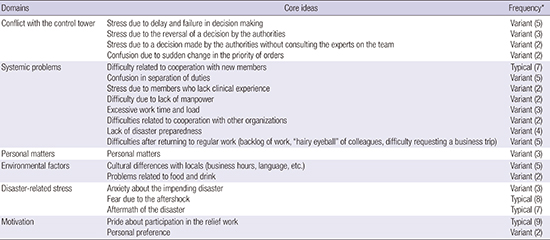1. Ministry of Home Affairs (NP). Nepal Earthquake 2072: Situation Update as of 11th May. Kathmandu: Ministry of Home Affairs;2015.
2. Berger W, Coutinho ES, Figueira I, Marques-Portella C, Luz MP, Neylan TC, Marmar CR, Mendlowicz MV. Rescuers at risk: a systematic review and meta-regression analysis of the worldwide current prevalence and correlates of PTSD in rescue workers. Soc Psychiatry Psychiatr Epidemiol. 2012; 47:1001–1011.
3. Shin DY, Jeon MJ, Sakong J. Posttraumatic stress disorder and related factors in male firefighters in a metropolitan city. Korean J Occup Environ Med. 2012; 24:397–409.
4. Stellman JM, Smith RP, Katz CL, Sharma V, Charney DS, Herbert R, Moline J, Luft BJ, Markowitz S, Udasin I, et al. Enduring mental health morbidity and social function impairment in world trade center rescue, recovery, and cleanup workers: the psychological dimension of an environmental health disaster. Environ Health Perspect. 2008; 116:1248–1253.
5. Slottje P, Witteveen AB, Twisk JW, Smidt N, Huizink AC, van Mechelen W, Smid T. Post-disaster physical symptoms of firefighters and police officers: role of types of exposure and post-traumatic stress symptoms. Br J Health Psychol. 2008; 13:327–342.
6. Bills CB, Levy NA, Sharma V, Charney DS, Herbert R, Moline J, Katz CL. Mental health of workers and volunteers responding to events of 9/11: review of the literature. Mt Sinai J Med. 2008; 75:115–127.
7. Johal SS, Mounsey ZR. Finding positives after disaster: insights from nurses following the 2010-2011 Canterbury, NZ earthquake sequence. Australas Emerg Nurs J. 2015; 18:174–181.
8. Ogińska-Bulik N. Social support and negative and positive outcomes of experienced traumatic events in a group of male emergency service workers. Int J Occup Saf Ergon. 2015; 21:119–127.
9. Hill CE, Knox S, Thompson BJ, Williams EN, Hess SA, Ladany N. Consensual qualitative research: an update. J Couns Psychol. 2005; 52:196–205.
10. Armstrong K, Zatzick D, Metzler T, Weiss DS, Marmar CR, Garma S, Ronfeldt H, Roepke L. Debriefing of American Red Cross personnel: pilot study on participants’ evaluations and case examples from the 1994 Los Angeles earthquake relief operation. Soc Work Health Care. 1998; 27:33–50.
11. Marmar CR, McCaslin SE, Metzler TJ, Best S, Weiss DS, Fagan J, Liberman A, Pole N, Otte C, Yehuda R, et al. Predictors of posttraumatic stress in police and other first responders. Ann N Y Acad Sci. 2006; 1071:1–18.
12. Thoresen S, Tønnessen A, Lindgaard CV, Andreassen AL, Weisaeth L. Stressful but rewarding: Norwegian personnel mobilised for the 2004 tsunami disaster. Disasters. 2009; 33:353–368.
13. Alvarez J, Hunt M. Risk and resilience in canine search and rescue handlers after 9/11. J Trauma Stress. 2005; 18:497–505.
14. Ben‐Ezra M, Essar N, Saar R. Post-traumatic reactions among rescue personnel 96 hours after the Hilton Hotel bombing in Sinai: the effect of previous exposure. Stress Health. 2005; 21:269–272.
15. Zhen Y, Huang ZQ, Jin J, Deng XY, Zhang LP, Wang JG. Posttraumatic stress disorder of Red Cross nurses in the aftermath of the 2008 Wenchuan China Earthquake. Arch Psychiatr Nurs. 2012; 26:63–70.
16. Armagan E, Engindeniz Z, Devay AO, Erdur B, Ozcakir A. Frequency of post-traumatic stress disorder among relief force workers after the tsunami in Asia: do rescuers become victims? Prehosp Disaster Med. 2006; 21:168–172.
17. Liao SC, Lee MB, Lee YJ, Weng T, Shih FY, Ma MH. Association of psychological distress with psychological factors in rescue workers within two months after a major earthquake. J Formos Med Assoc. 2002; 101:169–176.
18. Fullerton CS, Ursano RJ, Wang L. Acute stress disorder, posttraumatic stress disorder, and depression in disaster or rescue workers. Am J Psychiatry. 2004; 161:1370–1376.
19. McCall M, Salama P. Selection, training, and support of relief workers: an occupational health issue. BMJ. 1999; 318:113–116.
20. American Psychiatric Association. Diagnostic and Statistical Manual of Mental Disorders : DSM-5. 5th ed. Washington, D.C.: American Psychiatric Association;2013.
21. Berninger A, Webber MP, Cohen HW, Gustave J, Lee R, Niles JK, Chiu S, Zeig-Owens R, Soo J, Kelly K, et al. Trends of elevated PTSD risk in firefighters exposed to the World Trade Center disaster: 2001-2005. Public Health Rep. 2010; 125:556–566.
22. Brackbill RM, Hadler JL, DiGrande L, Ekenga CC, Farfel MR, Friedman S, Perlman SE, Stellman SD, Walker DJ, Wu D, et al. Asthma and posttraumatic stress symptoms 5 to 6 years following exposure to the World Trade Center terrorist attack. JAMA. 2009; 302:502–516.
23. Perrin MA, DiGrande L, Wheeler K, Thorpe L, Farfel M, Brackbill R. Differences in PTSD prevalence and associated risk factors among World Trade Center disaster rescue and recovery workers. Am J Psychiatry. 2007; 164:1385–1394.
24. Yang M, Lee E, Choi JW, Kim HJ. PTSD and related factors among dispatched firefighters to rescue sites after the great japanese earthquake (running head: dispatched firefighters’ PTSD). Korean J Occup Environ Med. 2012; 24:167–179.








